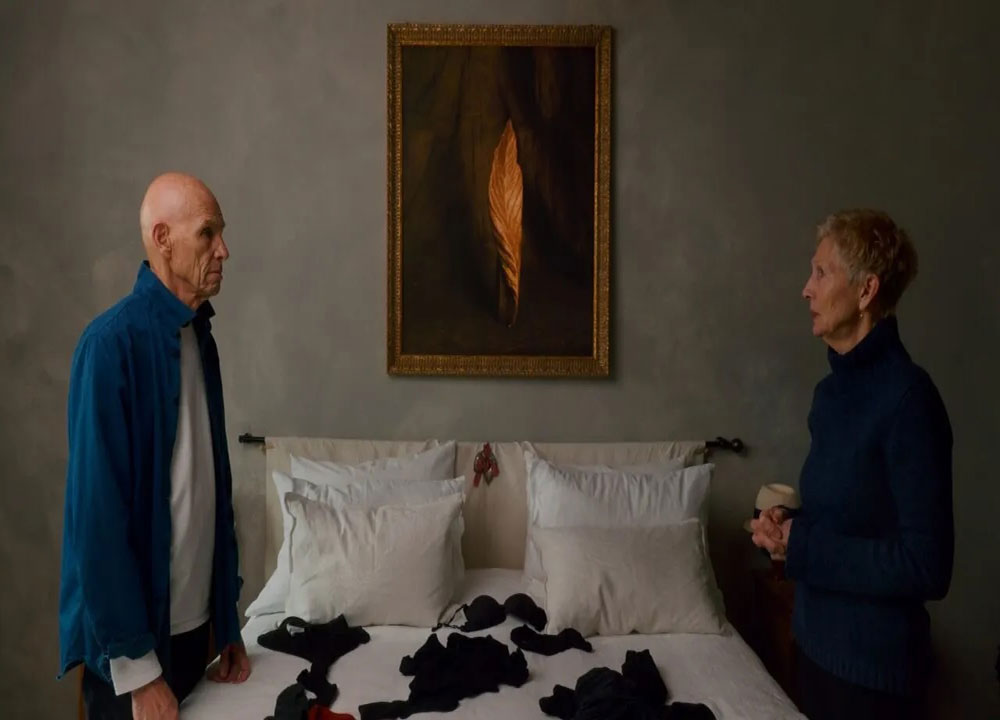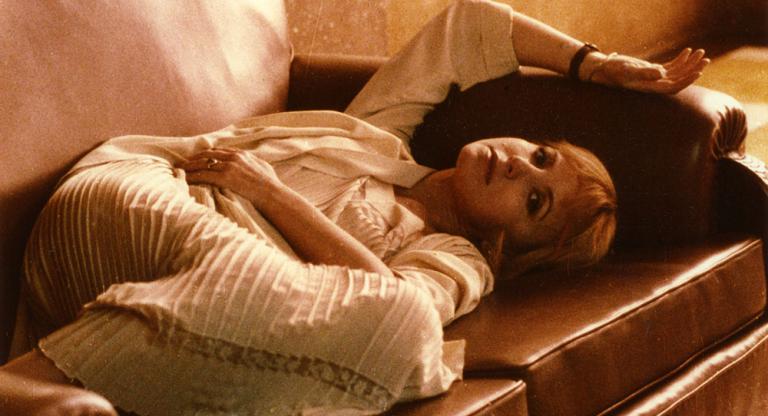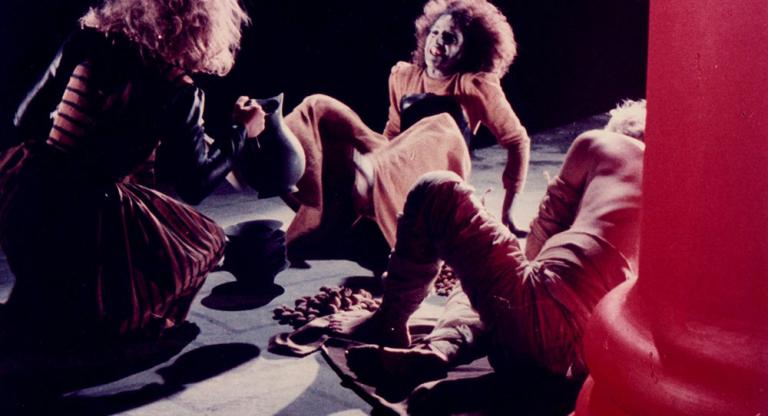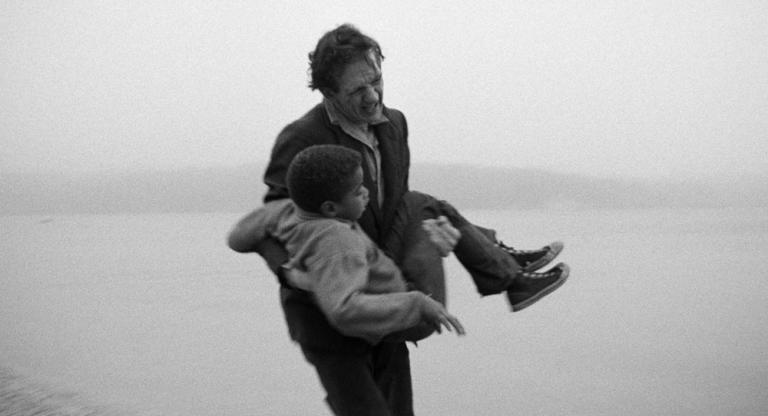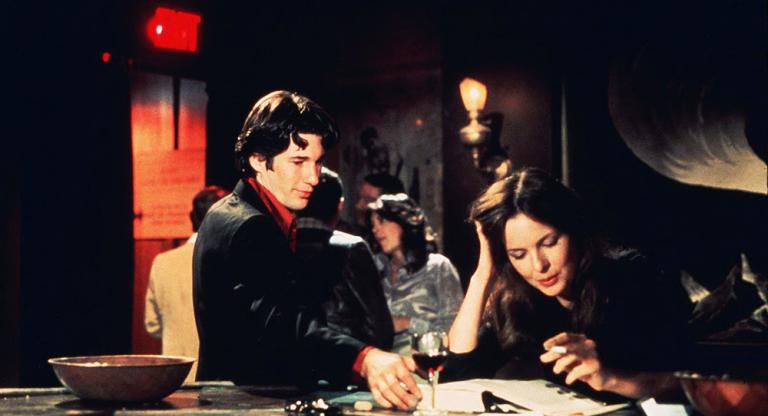Joel Meyerowitz and Maggie Barrett are the strangers in question, filmed over the course of a year by another couple, Manon Ouimet and Jacob Perlmutter. Both Meyerowitz and Barrett are artists—he, the famed Bronx-born photographer with multiple major exhibitions, and she, a British writer and visual artist whose career has taken a different path. In Two Strangers Trying Not to Kill Each Other (2024), they’re chronicled in life and in love, and mostly at home. And it’s somewhat a double portrait of artists—he at 84, she 75—but most of all, it’s a hyper-articulate record of a relationship in a constant state of becoming and renewal. These aren’t two people who sit across the dinner table and have nothing to say to each other after decades. The level of candor and the constant practice of tending and attending to one another are on display.
Meyerowitz is a bustling presence, very loving but also a handful, while Barrett feels the strain of health troubles; they’re active, but they do mull the horizon of their lives. Ouimet and Perlmutter, directing their debut feature, are there for all of it, shooting at “Maggie and Joel’s” homey perches on the Upper West Side and in perpetual-magic-hour Tuscany. “Everything is as tight as it could be,” Perlmutter says of the all-killer-no-filler feel of the movie, edited with lapidary precision after a year. Two Strangers premiered at CPH:DOX where it received special mention. After the world premiere—attended by the subjects, who bantered happily on stage after the standing ovation—I interviewed Ouimet and Perlmutter in a noisy Copenhagen hotel about how they pulled off their in-house vérité.
Nicolas Rapold: How did you propose the idea of the documentary to Meyerowitz and Barrett? From the Q&A at the premiere it sounded like you were able to engineer a meeting with Joel.
Jacob Perlmutter: I didn’t engineer it! What I will admit to is that I followed him for an extraordinary period of time, like 20 minutes, in and out of shops. But there was nothing planned. I wasn’t exactly sure it was him, but then I saw his Leica on his shoulder. And then I was intimidated and that’s why it took so long. And then I lost him. But later I met Joel and Maggie together, and I had this extraordinary hit of who they are as a couple. I could feel their energy, and it felt so inspiring, especially seeing an older couple who were still clearly in love but not in a schmaltzy way. They were just connected. There’s this saying I really like, which is that love isn’t looking into each other’s eyes, it’s looking in the same direction. And that’s really how I felt. Joel and Maggie had this kind of shared space.
A couple of years later I came across Maggie’s blog during the pandemic, and it’s this very open book about their lives. And I just cold-approached Maggie. They’re both so pragmatic and spiritual, and that’s such a great combination for the genesis of a project like this.
Manon Ouimet: The thing that interested me most was the fact that they were a couple in their later years, still very much in love, and I have very few examples of that in my own life. I haven’t really seen that portrayed before on the screen, so for me it was a no-brainer. And I wanted to be able to project into the future and see how our relationship might play out as a creative couple.
NR: Your movie has a strong feeling of now-ness—it’s present-tense, not an overview of two artists punctuated with scenes around the house. How did you settle on that approach?
MO: Our intention was always to make a film about their relationship in the present tense. We knew that we had to explore what their past was like—but what brought them to now. We did try and play with some archive, but it never sat within the film language of what we were creating. And obviously they were very generous in terms of how much they shared, and their vocabulary is so brilliant and eloquent and concise. They were really brilliant protagonists for that reason. We’re so lucky.
JP: Our radars are always scanning for impurities or manipulation, and we felt that this film flew when it was just being told in the present tense. And if you take the theme of mortality, of course we all live with our memories and they kick around in our minds, but Maggie and Joel are incredibly present people. They defy your impressions of older people. In the film, they’re moving house—they’re not moving into an old-age home. And they acknowledge the past and embrace it, but they are forward-looking people.
MO: You can even see it in the way that Joel approaches his work now. He’s looking back at his archive but looking at how to repurpose it to make new work now, rather than just examining what he has done and letting that be. He’s developing a new sense of self from his past.
NR: Manon, it sounded like they represent a kind of possible future for you. What sort of lessons did you take away from filming them?
MO: I came away with the understanding that there’s always potential to grow, and through growth you learn to communicate better with your partner, and through communication, you learn how to love yourself better and love the other person more. It’s not about arriving at a point in your life where it’s complete and you’re finished, you’ve done all the learning, you can retire. There is no sense of retirement in your personal growth. And from what I’ve seen of Maggie and Joel, there is also no retirement from creativity.
JP: Definitely. I suppose what I saw with Maggie and Joel when I met them on the street for the first time was the loving respect that they had for each other. It’s a kind of optimism. I think their romance is a combination of pragmatism and play, and there’s a wider metaphorical function of how the world sometimes is, or should be, and how human beings should all respect each other. We spent a very deep year with them.
NR: What sort of ground rules were set? Is it true you were sleeping in their house?
JP: Yeah, from day one. When we first spoke about the project with them, they said, listen, why don’t you come and stay with us, and if you want to move out at some point, then you can, but you might as well come and stay rather than staying up the road somewhere. That was just the most incredibly generous access, not only for being able to film whenever we felt right, but also because when you cohabit with someone, it’s not like there’s any level of presentation or artifice. It was constant, and with that level of continuity from the get-go, the way that we got to know them and they got to know us created a level of respect and trust.
MO: It was magic.
NR: Did you, or they, ever need to take a rest?
MO: We did shooting blocks. We spent a few weeks in Tuscany and then we would go home and then we’d go to New York for a few weeks and then come home. We didn’t live with them for the whole year, but when we were filming, we were always with them.
JP: I mean, obviously, there are certain times where if someone wanted to go and take a nap or go to the bathroom or something, it’s basic human rules. But there was no set agenda, and the first few weeks we were staying with them, it was such a process of us acclimatizing and filming things and then privately reviewing the footage and seeing what felt right, technical tweaks, and things like that. When Maggie slipped and broke her femur, by that point we had such a close relationship with them, and we respect their privacy, but at the same time they understood that those kind of dramatic moments were of narrative value because of what we were doing.
MO: We had to very delicately ask, what is your position on this, and they very gracefully turned around and said, we’re doing it all together—this whole year is together!
NR: What about when they have an argument—what was it like being in the room for that?
MO: Oh, wow. It was a journey. I was really very grateful for it. I was able to witness something I’ve never really witnessed before, which is two people resolve an argument on the spot. It meant a lot that they went there in front of us.
JP: Look, it was an unexpected moment. And it was a small room.
MO: [Laughs]
NR: So you’re hiding under a couch...
MO: Up against a wall like this [hugs self].
JP: It was as intense as you would imagine, and it was surreal watching something so personal unfolding in that kind of way. Manon was sitting with the sound equipment and I was sitting with the camera, and so I’m not even sure we looked at each other. And you kind of don’t want to breathe because what’s happening is happening. But the way that they resolved it and the understanding that came from it, there was such a beauty to it. I wish all arguments could have that kind of ending.
MO: With humor.
JP: With humor and love and understanding and a kind of a promise.
NR: Did you ever have differing viewpoints on what you were both seeing, or take sides in your head a little?
MO: I think our need to respect the both of them equally was stronger than anything else.
JP: What we learned is that embracing our fallibilities is actually our strength, by watching Maggie and Joel do that in a dance for themselves and work through things. I think that was also why it was very important to set it in the now, because this is about real-life drama. We don’t have the history, and we haven’t lived it. So it’s like we weren’t qualified to make judgments, and we didn’t want to make judgments. We’d only known them for such a short period of time. I mean, we talked about things all the time, you can’t help it, but it’s so not binary. We went about embracing everything, and it’s a kind of street photography attitude that Joel alludes to in that talk that he gives [to an audience] where he says it’s about taking it all in—love and pain and anger.
NR: What kind of cameras were you using?
MO: We were working with the Leica SL2-S. They’re photography cameras, DSLRs, with a video [capability]. I think this is the first film that has been made on them.
JP: They’re absolutely tiny. Their size and unobtrusive nature enabled us to blend in. The shots are always locked off, so a lot of times we would just leave them on tripods and they just became part of the furniture of the house. They’re both used to having cameras lying around the house anyway, so it was just another sculptural element for them. But they are incredible cameras, and the film’s intimacy is due to our relationship but it’s really the unobtrusiveness of the cameras.
NR: I was also curious about lighting, because the movie looks so alive. Were you replacing any lights, as can happen in documentary?
MO: In Tuscany we did rig a couple lights that were permanently up during the time we were there, to minimize any sort of interruptions in the day. But generally speaking we used natural daylight as much as we could.
JP: And microphones on Maggie and Joel, and microphones hidden around the house. The whole thing was like a live shooting location.
NR: Like a TV studio.
JP: Like a TV studio. [MO laughs] A big inspiration visually for this film was The Truffle Hunters [2020]. We were like, “How is something so authentic and underplayed, so stunning? How does this whole film look like a Renaissance painting?” And so we looked at the American Cinematographer article and saw the way that they rigged these ARRI SkyPanels, which for us were too heavy. But because the house that Maggie and Joel were living in was an old converted hay barn, it had a big beam with a mezzanine, which is where the studio is up top. So we were able to rig a couple of Chinese lanterns and just leave them permanently there. They were unobtrusive and gave us the light that we needed.
NR: This being a film about two artists, you do show Maggie and Joel at work—her writing away, and him organizing archives or shooting out in the street. But there’s a kind of absurdity to how he shoots, moving around so much and clicking away. Was he supposed to look a little comical, in an endearing way?
JP: Yeah. Maggie puts it very, very well in her poem at the end of the film about what she calls the camera, which is “The Other Woman.” And it’s ironic because the camera that Joel uses, which is what makes him Joel Meyerowitz the photographer and visionary artist, also happens to be this comically small thing that is always in his hand. I’m really glad that comes across. Because the frames are so wide a lot of the time, but it’s not like these fetishized slo-mo shots of him taking pictures. It’s a little thing, and it is comical, and the sound is commonplace. And his physicality, when you watch him moving around, especially at his age, to get these particular shots, is mind-blowing.
MO: Yeah, and how animated he is.
JP: How animated and how consistent. It’s what makes him who he is.
Conversations is on view through June 7 at Howard Greenberg Gallery. The year-long show Joel Meyerowitz 1962-1980 at the Tate Modern in London continues through November.
